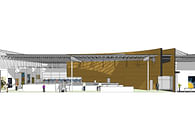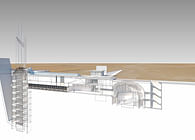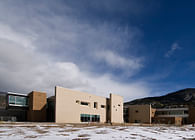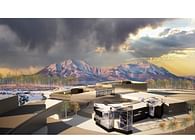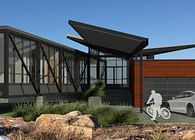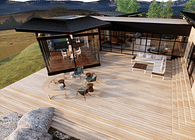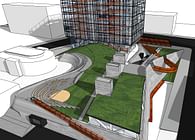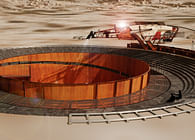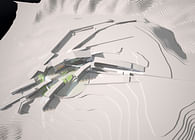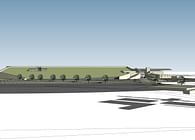
Colorado Springs, CO, US
BILLBOARD HOUSE - “Memories of the Ruined Landscape”
Ideas on the role of Typology, Memory, and Identity in Architecture (originally designed in 1987 during graduate studies)
“We are only just beginning to question what our lives would look like if duality were no longer an antecedent to every discussion - up/down, left/right, male/female, black/white, gay/straight. If dualistic definitives no longer define our concepts of existence, how do we see ourselves and the natural world around us? If our perception of the natural world is no longer restricted by these base prejudices of ‘either/or’, can the alternative found in a broad range of consideration begin to expand the possibilities of our experience?
Our path has traveled from low and humbled stations, where the struggle for daily survival consumed our every moment, to our current position of hubris, where our technologies have gained us the ability to alter our environment for our own comforts, concerns, and pleasures. As we begin to realize that our philosophical constructs, some of them centuries old, are in dire need of revision, we find that this revision requires far more than a simple adjustment in behavior. It requires a re-examination of the generative antecedents that drive some of our most fundamental beliefs, many of which have for centuries define the ontological nature of the human condition itself."
- Don Octavia Alejandro de Silva
ABSTRACT - Duality and the incumbency of the Hybrid:
What would happen if we unearthed a Stealth fighter at the site of an ancient Mayan city? It would answer nothing, but it would question everything. As context for each other they would inherently become something quite new. Regardless of the power and magnificence each has as individual objects, and as confounding as their union may seem, the Mayan city could never again be seen as just an ancient city, and the Stealth fighter could never again be seen as just an advanced piece of military technology.
We now begin to speak of both context and object in terms of the mutually reciprocal and the ‘in-between’— in essence, we are speaking of the rarified hybrid - the mechanism of transformation that helps us grow and strengthen. The hybrid is both and neither at the same time, and rather than focusing on a chronology of consistency, we are more concerned with the consistency of the variable.
When speaking of the hybrid, one is dealing with the notions of abstraction and position. By definition, the hybrid-type is an abstracted resolution caused by the necessity of merger between dissimilar ideas or objects. The final product is not a compromise of the two problems, nor is it an apology, but rather a charged morphosis. The origin of the hybrid is begat by the idea of need, but what gives the hybrid its growth, it's method, it's presence and it's energy is the idea of desire.
SOCIAL NARRATIVE - Gender, Identity, and the notion of Introverted and Extroverted Space:
When speaking of the hybrid, one is dealing with the notions of abstraction and position. By definition, the hybrid-type is an abstracted resolution caused by the necessity of merger between dissimilar ideas or objects. The final product is not a compromise of the two problems, nor is it an apology, but rather a charged morphosis. The origin of the hybrid is begat by the idea of need, but what gives the hybrid its growth, it's method, it's presence and it's energy is the idea of desire
CULTURAL NARRATIVE - Global Consumerism; a question of Sovereignty:
When speaking of the hybrid, one is dealing with the notions of abstraction and position. By definition, the hybrid-type is an abstracted resolution caused by the necessity of merger between dissimilar ideas or objects. The final product is not a compromise of the two problems, nor is it an apology, but rather a charged morphosis. The origin of the hybrid is begat by the idea of need, but what gives the hybrid its growth, it's method, it's presence and it's energy is the idea of desire
URBAN DESIGN NARRATIVE - Density and the notion of the Found Object:
When speaking of the hybrid, one is dealing with the notions of abstraction and position. By definition, the hybrid-type is an abstracted resolution caused by the necessity of merger between dissimilar ideas or objects. The final product is not a compromise of the two problems, nor is it an apology, but rather a charged morphosis. The origin of the hybrid is begat by the idea of need, but what gives the hybrid its growth, it's method, it's presence and it's energy is the idea of desire
ARCHITECTURAL NARRATIVE - (Re) coding and the notion of De-familiarization:
In programmatic terms, the investigation of precedents is essential to uncover the inherent problems of transformation and juxtaposition. One must know the thoughts of the disease before one can conjure the cure. The usual problems resultant of this investigation into the 'disease' are those of methodology and viewpoint (reference). Once the problems of need are established, it is common to produce not an abstracted resolution, but more of a programmatic collision. By this, there is a transformational problem in both idea and method. After the programmatic problems are identified, the hybrid-type no longer deals with the synthetic and syntactic, but rather with the analytic and referential.
Much like the surrealist, the hybrid takes an eschewed view of the subject matter. It is a simultaneous two-way mirror that looks at the resolution through the problem, and the problem through the resolution. The clarity of the reference point, however, is essential. Like the chance happening of an umbrella and a sewing machine, the meaning of the merger is unclear unless the referential idea of surgeon is presented in no uncertain terms.
The reclamation of our landscape can occur when elements of singular ruination are transformed into referential elements of use.
The Billboard House transforms its primary function from one of observation to one of active inquisition. In this form, the billboard is no longer simply a symbol within the landscape, but rather an active participant. A previous concentration on the billboard as an object in the landscape is subjugated to its suggestion of an environment beyond the highway. What was once centered on nowhere is now an indicator of its exact location.
The idea of habitable space within the confines of an advertisement billboard brings to mind several notions about the rituals of habitation and the narratives between architecture, landscape, use, and alternative atmospheres. The billboard stands in a secluded landscape and is seen in and of itself as a solitary figure. By its own nature, the billboard is less a 'natural' setting for living, and therefore gives itself much more readily to the contemplative setting of de-familiarization. Although the billboard does not de-'familiarize the spaces and events that take place within, it does, nevertheless, de-familiarize our normal behavior and call to attention our own need to abstract what might otherwise be ‘natural’ activities.
In context to its' secluded setting, the notions of sequence and passage between physical and mental atmospheres become pictorial if not also programmatic. The uses, activities, and incidents, used as parameters for program, can be superimposed on the spatial sequences and therefore suggest a fictitious collection of mental environments. The replacement of existing mental conventions and transfer of ideas and images dilate the correspondences between normative sequences and formative symbols.
The narrative between pictorial and programatic sequences, as well as the dialogue between architecture and landscape become, therefore, a forum for investigation into the intersections where function as imperative is transformed to fit a new set of meaning
Status: Unbuilt
Location: Los Angeles, CA, US
My Role: Principal, Lead Design Architect, Project Architect
Additional Credits: Takashi Ichinose, Brian Elyo, Ryan Ekstrom, Richard Mapes, Kenny LaGreca (structural engineer)

